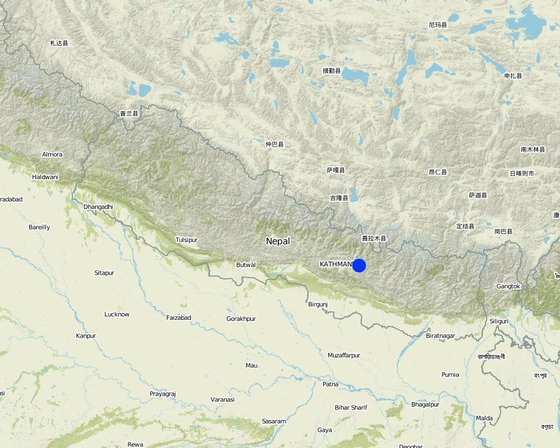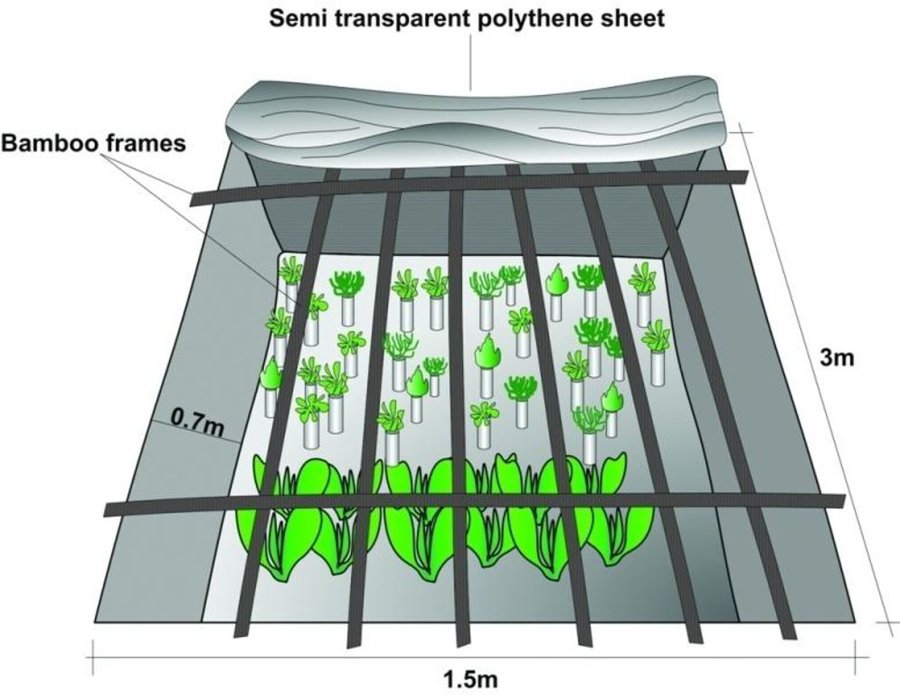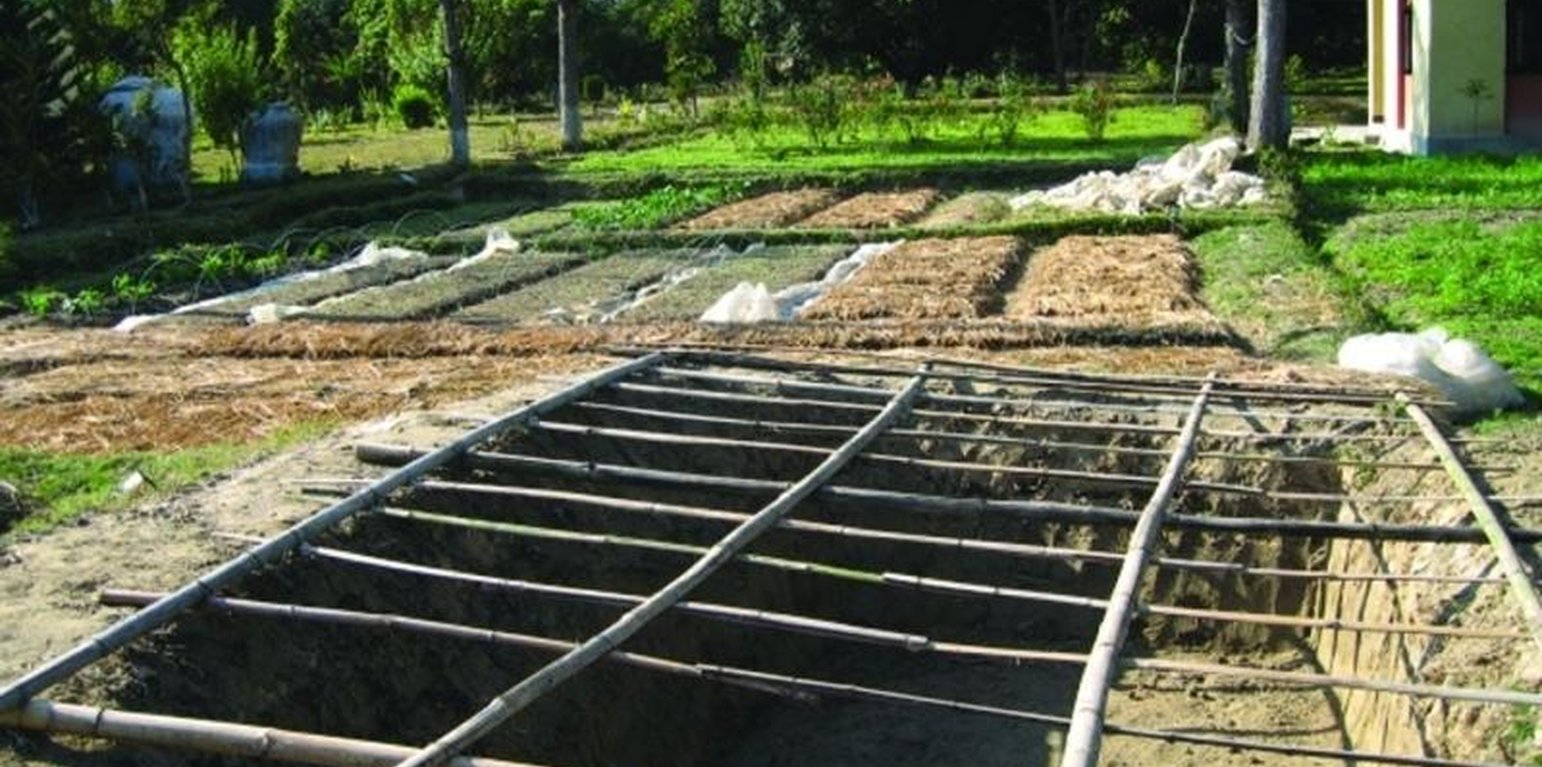Polypit nursery
(Nepal)
Plastic-Khalte nursery - Nepali
Description
A simple, inexpensive and practical method for raising healthy plant seedlings
During the winter in Nepal’s middle mountains, the soil temperature generally remains at 5-10 degree celsius above the ambient air temperature. This principle was used to design a simple, inexpensive, and effective nursery technology for raising vegetable and horticulture seedlings in colder regions. The polypit technology allows seedlings to be raised by protecting them from the freezing temperatures that occur mostly at night.
Polypits are about 1m deep pits dug into the ground and covered with semitransparent polythene sheets, preferably UV stabilised and supported on bamboo frames. A 30 cm high mud wall is built across the slope on the upper side of the pit. The polythene sheet is sealed on the upper side of the pit, leaving three sides unsealed but held down with stones that can be lifted to access the pit. The base and sides of the polypit are left as they are with no form of plastering.
The polythene sheet covering the pit reduces the photosynthetic photon flux (PPF) by around 30% inside the pit, still allowing sufficient sunlight to reach the plants inside. The polythene is usually removed during the day from 11 am to 4 pm to allow full sunlight to reach the plants except on rainy and very cold days. A modified version of these polypits - only 70 cm deep - were used in the Jhikhu Khola watershed to grow vegetable seedlings during the winter. The pits can be made of any reasonable size depending on the number of seedlings to be grown and the layout of the land. The Jhikhu Khola pits were about 3m long, 1.5m wide, and 0.7m deep.
Since the polypits are closed at night, the CO2 released by the plants and soil microbes accumulates and increases to well above levels outside the pit. In a completely sealed polypit, the CO2 concentration could reach up to 3000 ppm during the night which would be harmful for plants. Thus the polythene cover is only loosely sealed along the edges at night to regulate and maintain the concentration of CO2 at about two to four times the ambient concentration.
The warmer protected conditions and CO2 enrichment leads to extra growth and biomass gain for plants grown inside the pits during the winter. This technology is easy to maintain with the only maintenance costs being to repair damaged polythene sheets and frames.
The polypit technology is useful for mountain farmers where water scarcity and low temperatures limit the potential to raise quality seedlings. The technology is being promoted in the northwest Indian state of Uttarakhand, although only a few farmers have adopted it so far. It is a very promising technology and its use should be encouraged by hill farmers and research and development organisations engaged in raising seedlings. The technology needs more participatory action research to improve it and to encourage more farmers to adopt it spontaneously.
Location

Location: Kavrepalanchowk district/Jhikhu Khola watershed, Nepal
No. of Technology sites analysed:
Geo-reference of selected sites
Spread of the Technology: applied at specific points/ concentrated on a small area
In a permanently protected area?:
Date of implementation: less than 10 years ago (recently)
Type of introduction
-
through land users' innovation
-
as part of a traditional system (> 50 years)
-
during experiments/ research
-
through projects/ external interventions
Classification of the Technology
Main purpose
-
improve production
-
reduce, prevent, restore land degradation
-
conserve ecosystem
-
protect a watershed/ downstream areas – in combination with other Technologies
-
preserve/ improve biodiversity
-
reduce risk of disasters
-
adapt to climate change/ extremes and its impacts
-
mitigate climate change and its impacts
-
create beneficial economic impact
-
create beneficial social impact
Land use
-
Cropland
- Annual cropping: cereals - maize, legumes and pulses - other, oilseed crops - sunflower, rapeseed, other, vegetables - other, rice, wheat
Number of growing seasons per year: 3
Water supply
-
rainfed
-
mixed rainfed-irrigated
-
full irrigation
Purpose related to land degradation
-
prevent land degradation
-
reduce land degradation
-
restore/ rehabilitate severely degraded land
-
adapt to land degradation
-
not applicable
Degradation addressed
SLM measures
-
structural measures - S4: Level ditches, pits
Technical drawing
Technical specifications
Poly pit covered with semi transparent plastic sheet which is supported on a bamboo farme.
Technical knowledge required for field staff / advisors: low
Technical knowledge required for land users: low
Main technical functions: protecting seedlings from frost, reduction of water loss, carbon dioxide enrichment
Structural measure: pit
Depth of ditches/pits/dams (m): 0.7m
Width of ditches/pits/dams (m): 1.5 m
Length of ditches/pits/dams (m): 3 m
Construction material (earth): a mud wall is made about 30 cm high from the ground, sloping on the two sides.
Construction material (wood): to place semi transparent plastic on a frame.
Construction material (other): plastic sheet: to cover the pit, rope, wire: frame preparation

Author: Madhav Dhakal, A.K. Thaku
Establishment and maintenance: activities, inputs and costs
Calculation of inputs and costs
- Costs are calculated: per Technology unit (unit: Polypit nursery)
- Currency used for cost calculation: USD
- Exchange rate (to USD): 1 USD = n.a
- Average wage cost of hired labour per day: 2.10
Most important factors affecting the costs
The plastic sheet , but it is easily affordable by the land users.
Establishment activities
-
Determine the appropriate size (length, width and depth) of the pit (Timing/ frequency: beginning of the winter season)
-
Mark the area for soil excavation (Timing/ frequency: beginning of the winter season)
-
Excavate soil from the marked area (Timing/ frequency: beginning of the winter season)
-
Make a mud wall (~30 cm high) from the ground, sloping on two sides (Timing/ frequency: beginning of the winter season)
-
Make a bamboo fram of an appropriate size (Timing/ frequency: beginning of the winter season)
-
Lay the frame over the pit with one end resting on the mud wall (Timing/ frequency: beginning of the winter season)
-
Lay the plastic sheet over the frame (Timing/ frequency: beginning of the winter season)
-
Seal the polythene sheet on the higher side of the mud wall and leave three sides unsealed (Timing/ frequency: beginning of the winter season)
-
Lay the other three sides of the polythene sheet normally at ground level and weigh down with stones that can be removed to access the pit (Timing/ frequency: beginning of the winter season)
-
The base and sidesof the polypit do not need any form of plastering (even with mud) (Timing/ frequency: beginning of the winter season)
Establishment inputs and costs (per Polypit nursery)
| Specify input |
Unit |
Quantity |
Costs per Unit (USD) |
Total costs per input (USD) |
% of costs borne by land users |
|
Labour
|
| Construction of polypit nursery |
Persons/unit |
1.0 |
2.1 |
2.1 |
100.0 |
|
Construction material
|
| Plastic |
unit |
1.0 |
4.0 |
4.0 |
|
| Bamboo |
unit |
1.0 |
1.3 |
1.3 |
100.0 |
| Rope |
unit |
1.0 |
0.2 |
0.2 |
100.0 |
| Total costs for establishment of the Technology |
7.6 |
|
| Total costs for establishment of the Technology in USD |
7.6 |
|
Maintenance activities
-
The polythene cover is opened to acclimatized the plants to the outside environment (Timing/ frequency: 11:00- 16:00/Every day)
-
Cleaning the pit (Timing/ frequency: After trasplanting the seedlings/ once or twice in)
-
Replacing the frame and polythene sheet if it gets damaged. (Timing/ frequency: before raising nursery/In case of damage)
Maintenance inputs and costs (per Polypit nursery)
| Specify input |
Unit |
Quantity |
Costs per Unit (USD) |
Total costs per input (USD) |
% of costs borne by land users |
|
Labour
|
| Maintaining the pit |
Persons/unit |
1.0 |
2.1 |
2.1 |
100.0 |
| Total costs for maintenance of the Technology |
2.1 |
|
| Total costs for maintenance of the Technology in USD |
2.1 |
|
Natural environment
Average annual rainfall
-
< 250 mm
-
251-500 mm
-
501-750 mm
-
751-1,000 mm
-
1,001-1,500 mm
-
1,501-2,000 mm
-
2,001-3,000 mm
-
3,001-4,000 mm
-
> 4,000 mm
Agro-climatic zone
-
humid
-
sub-humid
-
semi-arid
-
arid
Specifications on climate
Average annual rainfall in mm: 1200.0
Thermal climate class: subtropics
Slope
-
flat (0-2%)
-
gentle (3-5%)
-
moderate (6-10%)
-
rolling (11-15%)
-
hilly (16-30%)
-
steep (31-60%)
-
very steep (>60%)
Landforms
-
plateau/plains
-
ridges
-
mountain slopes
-
hill slopes
-
footslopes
-
valley floors
Altitude
-
0-100 m a.s.l.
-
101-500 m a.s.l.
-
501-1,000 m a.s.l.
-
1,001-1,500 m a.s.l.
-
1,501-2,000 m a.s.l.
-
2,001-2,500 m a.s.l.
-
2,501-3,000 m a.s.l.
-
3,001-4,000 m a.s.l.
-
> 4,000 m a.s.l.
Technology is applied in
-
convex situations
-
concave situations
-
not relevant
Soil depth
-
very shallow (0-20 cm)
-
shallow (21-50 cm)
-
moderately deep (51-80 cm)
-
deep (81-120 cm)
-
very deep (> 120 cm)
Soil texture (topsoil)
-
coarse/ light (sandy)
-
medium (loamy, silty)
-
fine/ heavy (clay)
Soil texture (> 20 cm below surface)
-
coarse/ light (sandy)
-
medium (loamy, silty)
-
fine/ heavy (clay)
Topsoil organic matter content
-
high (>3%)
-
medium (1-3%)
-
low (<1%)
Groundwater table
-
on surface
-
< 5 m
-
5-50 m
-
> 50 m
Availability of surface water
-
excess
-
good
-
medium
-
poor/ none
Water quality (untreated)
-
good drinking water
-
poor drinking water (treatment required)
-
for agricultural use only (irrigation)
-
unusable
Water quality refers to:
Is salinity a problem?
Occurrence of flooding
Characteristics of land users applying the Technology
Market orientation
-
subsistence (self-supply)
-
mixed (subsistence/ commercial)
-
commercial/ market
Off-farm income
-
less than 10% of all income
-
10-50% of all income
-
> 50% of all income
Relative level of wealth
-
very poor
-
poor
-
average
-
rich
-
very rich
Level of mechanization
-
manual work
-
animal traction
-
mechanized/ motorized
Sedentary or nomadic
-
Sedentary
-
Semi-nomadic
-
Nomadic
Individuals or groups
-
individual/ household
-
groups/ community
-
cooperative
-
employee (company, government)
Age
-
children
-
youth
-
middle-aged
-
elderly
Area used per household
-
< 0.5 ha
-
0.5-1 ha
-
1-2 ha
-
2-5 ha
-
5-15 ha
-
15-50 ha
-
50-100 ha
-
100-500 ha
-
500-1,000 ha
-
1,000-10,000 ha
-
> 10,000 ha
Scale
-
small-scale
-
medium-scale
-
large-scale
Land ownership
-
state
-
company
-
communal/ village
-
group
-
individual, not titled
-
individual, titled
Land use rights
-
open access (unorganized)
-
communal (organized)
-
leased
-
individual
Water use rights
-
open access (unorganized)
-
communal (organized)
-
leased
-
individual
Access to services and infrastructure
Impacts
Socio-economic impacts
land management
the pit interrupted land preparation
Socio-cultural impacts
SLM/ land degradation knowledge
About the polypit and their advantages
Ecological impacts
soil moisture
Inside the polypit high relative humidity is maintained.
Protection of seedlings against frost
Quality of seedlings
customers prefer to buy seedlings grown in polypits compared to those grown outside
Cost-benefit analysis
Benefits compared with establishment costs
Short-term returns
very negative
very positive
Long-term returns
very negative
very positive
Benefits compared with maintenance costs
Short-term returns
very negative
very positive
Long-term returns
very negative
very positive
Climate change
Gradual climate change
annual temperature increase
not well at all
very well
Climate-related extremes (disasters)
not well at all
very well
not well at all
very well
not well at all
very well
not well at all
very well
Other climate-related consequences
not well at all
very well
Adoption and adaptation
Percentage of land users in the area who have adopted the Technology
-
single cases/ experimental
-
1-10%
-
11-50%
-
> 50%
Of all those who have adopted the Technology, how many have done so without receiving material incentives?
-
0-10%
-
11-50%
-
51-90%
-
91-100%
Number of households and/ or area covered
2 households
Has the Technology been modified recently to adapt to changing conditions?
To which changing conditions?
-
climatic change/ extremes
-
changing markets
-
labour availability (e.g. due to migration)
Conclusions and lessons learnt
Strengths: land user's view
-
The survival rate for vegetable seedlings is higher and seedlings mature about two weeks earlier than if grown outside where they take about one month to be ready, leading to additional income for farmers
How can they be sustained / enhanced? Every aspect of the technology should be highlighted through experience sharing programmes
Strengths: compiler’s or other key resource person’s view
-
Polypits are a simple, inexpensive, practical and effective technique for raising and protecting plant seedlings from severe winter temperatures.They can be called ‘poor farmers greenhouses’
How can they be sustained / enhanced? More dissemination and awareness raising activities are needed to inform more farmers about the benefits of this technology
-
The high relative humidity in polypits means that watering only needs to be carried out once or twice a month in comparison to fi ve to six times for open nursery beds, thus saving labour and water
How can they be sustained / enhanced? Every aspect of the technology should be highlighted through experience sharing programmes
-
The more physical conditions and CO2 enrichment in the pits during the winter months are refl ected in the extra growth and biomass gain of plants grown inside the pits
How can they be sustained / enhanced? As above
Weaknesses/ disadvantages/ risks: land user's viewhow to overcome
-
In the demonstration, the bamboo frame to hold the sheet was too heavy making it diffi cult for the farmer to remove the frame and work inside.
Use a modifi ed frame with a space built in to allow a person to enter the pit easily without having to remove the frame.
Weaknesses/ disadvantages/ risks: compiler’s or other key resource person’s viewhow to overcome
-
In completely sealed polypits, the CO2 concentration can become so high during the night that it harms the plants
Only loosely seal the sheet at night to regulate and maintain the CO2 concentration
References
Reviewer
-
David Streiff
-
Alexandra Gavilano
Date of documentation: June 7, 2011
Last update: June 4, 2019
Resource persons
-
Sanjeev Bhuchar - SLM specialist
-
Isabelle Providoli - SLM specialist
-
Madhav Dhakal - SLM specialist
Full description in the WOCAT database
Documentation was faciliated by
Institution
- ICIMOD International Centre for Integrated Mountain Development (ICIMOD) - Nepal
Project
Key references
-
Bhuchar, S. (2004) Polypit: a Green-chamber for Poor Farmers, an article prepared for PARDYP Quarterly e-Newsletter-8, ICIMOD, Kathmandu: ICIMOD
-
Palni, L.M.S.; Bhuchar, S.; Kothyari, B.P. (1994) ‘A Simple Polypit can Greatly Reduce Nursery Time of Tree Seedlings”. In Journal of HIMA-PARYAVARAN, 6(2):10-11: GBPIHED- Almora
-
Vyas, P.; Bisht, M.S.; Bhuchar, S.; Sharma, S.; Palni, L.M.S. (1999) ‘Polypit: An Improved Technique for Raising Nursery Plants’. In Journal of Sustainable Forestry, 8(1): 43-59: GBPIHED- Almora







